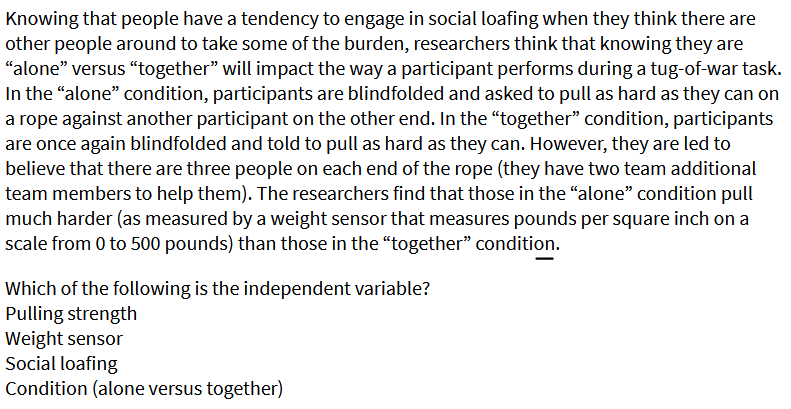Knowing that people have a tendency to engage in social loafing when they think there are other people around to take some of the burden, researchers think that knowing they are "alone" versus “together" will impact the way a participant performs during a tug-of-war task. In the "alone" condition, participants are blindfolded and asked to pull as hard as they can on a rope against another participant on the other end. In the “together" condition, participants are once again blindfolded and told to pull as hard as they can. However, they are led to believe that there are three people on each end of the rope (they have two team additional team members to help them). The researchers find that those in the "alone" condition pull much harder (as measured by a weight sensor that measures pounds per square inch on a scale from 0 to 500 pounds) than those in the "together" condition. Which of the following is the independent variable? Pulling strength Weight sensor Social loafing Condition (alone versus together)
Knowing that people have a tendency to engage in social loafing when they think there are other people around to take some of the burden, researchers think that knowing they are "alone" versus “together" will impact the way a participant performs during a tug-of-war task. In the "alone" condition, participants are blindfolded and asked to pull as hard as they can on a rope against another participant on the other end. In the “together" condition, participants are once again blindfolded and told to pull as hard as they can. However, they are led to believe that there are three people on each end of the rope (they have two team additional team members to help them). The researchers find that those in the "alone" condition pull much harder (as measured by a weight sensor that measures pounds per square inch on a scale from 0 to 500 pounds) than those in the "together" condition. Which of the following is the independent variable? Pulling strength Weight sensor Social loafing Condition (alone versus together)
Trigonometry (MindTap Course List)
8th Edition
ISBN:9781305652224
Author:Charles P. McKeague, Mark D. Turner
Publisher:Charles P. McKeague, Mark D. Turner
Chapter1: The Six Trigonometric Functions
Section: Chapter Questions
Problem 1RP: Although Pythagoras preceded William Shakespeare by 2,000 years, the philosophy of the Pythagoreans...
Related questions
Question
100%

Transcribed Image Text:Knowing that people have a tendency to engage in social loafing when they think there are
other people around to take some of the burden, researchers think that knowing they are
"alone" versus “together" will impact the way a participant performs during a tug-of-war task.
In the "alone" condition, participants are blindfolded and asked to pull as hard as they can on
a rope against another participant on the other end. In the “together" condition, participants
are once again blindfolded and told to pull as hard as they can. However, they are led to
believe that there are three people on each end of the rope (they have two team additional
team members to help them). The researchers find that those in the "alone" condition pull
much harder (as measured by a weight sensor that measures pounds per square inch on a
scale from 0 to 500 pounds) than those in the “together" condition.
Which of the following is the independent variable?
Pulling strength
Weight sensor
Social loafing
Condition (alone versus together)
Expert Solution
This question has been solved!
Explore an expertly crafted, step-by-step solution for a thorough understanding of key concepts.
Step by step
Solved in 2 steps

Knowledge Booster
Learn more about
Need a deep-dive on the concept behind this application? Look no further. Learn more about this topic, statistics and related others by exploring similar questions and additional content below.Recommended textbooks for you

Trigonometry (MindTap Course List)
Trigonometry
ISBN:
9781305652224
Author:
Charles P. McKeague, Mark D. Turner
Publisher:
Cengage Learning


Trigonometry (MindTap Course List)
Trigonometry
ISBN:
9781305652224
Author:
Charles P. McKeague, Mark D. Turner
Publisher:
Cengage Learning
